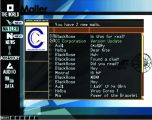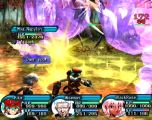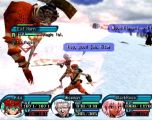Electronic Gaming Monthly 170 (Magazine): Difference between revisions
MysteryCorgi (talk | contribs) No edit summary |
MysteryCorgi (talk | contribs) mNo edit summary |
||
| (4 intermediate revisions by the same user not shown) | |||
| Line 12: | Line 12: | ||
|Dimensions = | |Dimensions = | ||
}} | }} | ||
<blockquote>Got Hack?<ref>Electric Gaming Monthly (p.58.) ''Issue 170''. (Ziff Davis Media.)(2003, February). Publisher.</ref> | <blockquote>'''Got Hack?'''<ref>Electric Gaming Monthly (p.58.) ''Issue 170''. (Ziff Davis Media.)(2003, February). Publisher.</ref> | ||
The past, present, and future of pseudo-online RPG .hack.<br /> | The past, present, and future of pseudo-online RPG .hack.<br /> | ||
Episodic gaming—breaking up one big story over a series of separate titles—has been a buzzworthy topic for years, but it took a developer built from the ashes of a construction company (yes, seriously) to really pull it off. (We'd count Sega's Shenmue, but it left players hanging without a final installment.) That developer is CyberConnect2 and the series is .hack (pronounced "dot hack"), an offline role-playing saga for Ps2 that thinks it's online-enabled. Its uniquie concept–simulating a massively multiplayer online RPG (called "The World") that begins infecting the real world–has helped .hack become one of the top-selling PS2 games so far this year. With the third of four planned installments, Outbreak, due for release in October, we thought it was time to put the .hack virus under the microscope. <br /> | Episodic gaming—breaking up one big story over a series of separate titles—has been a buzzworthy topic for years, but it took a developer built from the ashes of a construction company (yes, seriously) to really pull it off. (We'd count Sega's ''Shenmue'', but it left players hanging without a final installment.) That developer is CyberConnect2 and the series is ''.hack'' (pronounced "dot hack"), an offline role-playing saga for Ps2 that thinks it's online-enabled. Its uniquie concept–simulating a massively multiplayer online RPG (called "The World") that begins infecting the real world–has helped ''.hack'' become one of the top-selling PS2 games so far this year. With the third of four planned installments, ''Outbreak'', due for release in October, we thought it was time to put the ''.hack'' virus under the microscope. <br /> | ||
The underlying idea is to bring the exciting world of online gaming to the unplugged masses, according to CyberConnect2 President Hiroshi Matsuyama. ".hack started about three and a half years ago when we brough the concept to [publisher] Bandai," he explains. "That was when people started saying that online games were the next step. But many junior high and high school kids in Japan don't have their own phone lines and they can't pay the monthly fees, so we wanted to let them experience online games in an offline manner."<br /> | The underlying idea is to bring the exciting world of online gaming to the unplugged masses, according to CyberConnect2 President Hiroshi Matsuyama. "''.hack'' started about three and a half years ago when we brough the concept to [publisher] Bandai," he explains. "That was when people started saying that online games were the next step. But many junior high and high school kids in Japan don't have their own phone lines and they can't pay the monthly fees, so we wanted to let them experience online games in an offline manner."<br /> | ||
The inspiraiton of diving the game into episodes didn't come until the developers met with Bandai and .hack story writer Kazunori Ito. Together, they decided to use the traditional Japanese method of kisho tenketsu, or telling the story in four parts: introduction, rising action, turning point, and ending. From there, the .hack infection has spread to other forms of entertainment, including a popular anime series (available on DVD and currently running on Cartoon Network), manga comics series (coming in September from Tokyopop), and even a Japan-only version for cell phones. True fans will have their hands (and schedules) full—the anime and manga explore different parts of the story line, working to provide more background to the overarching .hack plot. <br /> | The inspiraiton of diving the game into episodes didn't come until the developers met with Bandai and .hack story writer Kazunori Ito. Together, they decided to use the traditional Japanese method of ''kisho tenketsu'', or telling the story in four parts: introduction, rising action, turning point, and ending. From there, the ''.hack'' infection has spread to other forms of entertainment, including a popular anime series (available on DVD and currently running on Cartoon Network), manga comics series (coming in September from Tokyopop), and even a Japan-only version for cell phones. True fans will have their hands (and schedules) full—the anime and manga explore different parts of the story line, working to provide more background to the overarching ''.hack'' plot. <br /> | ||
Though we've still got parts three and four to look forward to (see sidebar below), the game's future after that remains a mystery. "The concept of .hack is new and intereting—there's something slightly off about it," says Daisuke Uchiyama, project leader for Bandai. "So whatever the next .hack is going to be, it's going to have to be something like that again."<br /> | Though we've still got parts three and four to look forward to (see sidebar below), the game's future after that remains a mystery. "The concept of ''.hack'' is new and intereting—there's something slightly off about it," says Daisuke Uchiyama, project leader for Bandai. "So whatever the next ''.hack'' is going to be, it's going to have to be something like that again."<br /> | ||
As for .hack taking the plunge and actually becoming a real online game, don't count on it. "We get asked that question a a lot: 'Why don't you do an online game?'" Matsuyama says. "But we think what makes .hack interesting is [that it's a] fake online game, played offline. So we'd like to keep that. If we were to make an online game, it would be something completely different. <br /> | As for ''.hack'' taking the plunge and actually becoming a real online game, don't count on it. "We get asked that question a a lot: 'Why don't you do an online game?'" Matsuyama says. "But we think what makes ''.hack'' interesting is [that it's a] fake online game, played offline. So we'd like to keep that. If we were to make an online game, it would be something completely different. <br /> | ||
–Chris Johntston</blockquote | –Chris Johntston</blockquote> | ||
File:Electronic Gaming Monthly Issue 170 page-58.jpg| | [[File:Electronic Gaming Monthly Issue 170 page-58.jpg|right|300px|alt=scan of page 58 in its entirety]] | ||
<br /><gallery widths="200" perrow="3"> | |||
File:Imoq promo kite render.JPG|alt=The 3D renter of Kite featured in the article.|'''"Meet Kite, your person in .hack's "World." His blades slice, dice, julienne, and do waffle-cut fries."''' | File:Imoq promo kite render.JPG|alt=The 3D renter of Kite featured in the article.|'''"Meet Kite, your person in .hack's "World." His blades slice, dice, julienne, and do waffle-cut fries."''' | ||
</gallery> | </gallery> | ||
<br /><gallery widths="200" perrow="3" caption="'''&quot;.hack's in-game word balloon chatter (center) and e-mail and message-board setup (right) make you feel like you're online even though you're not.&quot;'''"> | |||
<br /> | File:Imoq promo blackrose kite grass.JPG|Kite and BlackRose relax on some grass | ||
.hack's in-game word balloon chatter (center) and e-mail and message-board setup (right) make you feel like you're online even though you're not. < | File:Mutation presskit BATTLE13.JPG|Kite, BlackRose, and Mistral fight a Red Wyrm in a grasslands area. | ||
File:Mutation presskit BROWSE2.JPG|The desktop mailer application. The wallpaper is the blue variant of the default. | |||
</gallery> | |||
<blockquote> | <blockquote> | ||
the end is near<br /> | '''the end is near'''<br /> | ||
.hack//Outbreak | '''.hack//Outbreak''' | ||
''Outbreak'', the third part of the ''.hack'' story (check back next month for a review), hits the PS2 in October, and picks up right where the last game, ''Mutation'', left off. This chapter brings in characters from the TV series (''.hack//Sign''), a new server with additional lands and towns to explore, two more kinds of the hog-like Grunties (think ''Final Fantasy's'' Chocobos, but...piggier) to race, new alien enemies, and more. Then, in December, the fourth and final installment, ''Quarantine'', completes the tale. Will Kite find out who's behind "The World" and save his friend from the coma he mysteriously slipped into after playing? Will Batman escape from The Penguin's sinister trap in time to rescue the Boy Wonder? Oh, wait. </blockquote><gallery widths="200" perrow="3"> | |||
File:Outbreak presskit Game B3.JPG|Kite, Wiseman, and Blackrose fight as two Mog Napylon converge atop of them. | |||
File:Outbreak presskit Game B13.JPG|Kite, Wiseman, and Blackrose fight an Evil Horn. | |||
</gallery> | |||
| Line 40: | Line 44: | ||
<references /> | <references /> | ||
[[Category:Print Media (Merch)]] | [[Category:Print Media (Merch)]][[Category:Magazines]][[Category:US Releases]][[Category:Electronic Gaming Monthly (Magazine)]] | ||
[[Category: Magazines]] | |||
[[Category: US Releases]] | |||
Latest revision as of 19:31, 30 December 2023
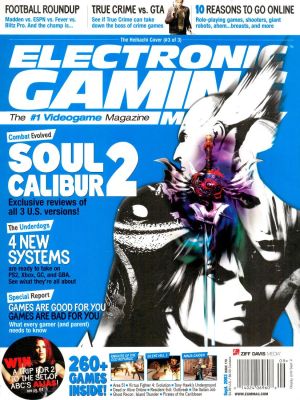
| |
Electronic Gaming Monthly
Issue 170 | |
Publisher
|
Ziff Davis Media
|
Pages
|
|
Volume
|
170
|
Cover Date
|
September 2003
|
In Store Date
|
Display Until September 2[1]
|
Price
|
$4.99 US/$6.50 Canada
|
Catalog Number
|
014024069608
|
Medium
|
Color Magazine
|
Dimensions
|
|
Got Hack?[2]
The past, present, and future of pseudo-online RPG .hack.
Episodic gaming—breaking up one big story over a series of separate titles—has been a buzzworthy topic for years, but it took a developer built from the ashes of a construction company (yes, seriously) to really pull it off. (We'd count Sega's Shenmue, but it left players hanging without a final installment.) That developer is CyberConnect2 and the series is .hack (pronounced "dot hack"), an offline role-playing saga for Ps2 that thinks it's online-enabled. Its uniquie concept–simulating a massively multiplayer online RPG (called "The World") that begins infecting the real world–has helped .hack become one of the top-selling PS2 games so far this year. With the third of four planned installments, Outbreak, due for release in October, we thought it was time to put the .hack virus under the microscope.
The underlying idea is to bring the exciting world of online gaming to the unplugged masses, according to CyberConnect2 President Hiroshi Matsuyama. ".hack started about three and a half years ago when we brough the concept to [publisher] Bandai," he explains. "That was when people started saying that online games were the next step. But many junior high and high school kids in Japan don't have their own phone lines and they can't pay the monthly fees, so we wanted to let them experience online games in an offline manner."
The inspiraiton of diving the game into episodes didn't come until the developers met with Bandai and .hack story writer Kazunori Ito. Together, they decided to use the traditional Japanese method of kisho tenketsu, or telling the story in four parts: introduction, rising action, turning point, and ending. From there, the .hack infection has spread to other forms of entertainment, including a popular anime series (available on DVD and currently running on Cartoon Network), manga comics series (coming in September from Tokyopop), and even a Japan-only version for cell phones. True fans will have their hands (and schedules) full—the anime and manga explore different parts of the story line, working to provide more background to the overarching .hack plot.
Though we've still got parts three and four to look forward to (see sidebar below), the game's future after that remains a mystery. "The concept of .hack is new and intereting—there's something slightly off about it," says Daisuke Uchiyama, project leader for Bandai. "So whatever the next .hack is going to be, it's going to have to be something like that again."
As for .hack taking the plunge and actually becoming a real online game, don't count on it. "We get asked that question a a lot: 'Why don't you do an online game?'" Matsuyama says. "But we think what makes .hack interesting is [that it's a] fake online game, played offline. So we'd like to keep that. If we were to make an online game, it would be something completely different.
–Chris Johntston
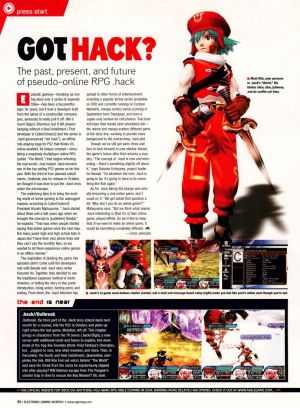
-
"Meet Kite, your person in .hack's "World." His blades slice, dice, julienne, and do waffle-cut fries."
- ".hack's in-game word balloon chatter (center) and e-mail and message-board setup (right) make you feel like you're online even though you're not."
-
Kite and BlackRose relax on some grass
-
Kite, BlackRose, and Mistral fight a Red Wyrm in a grasslands area.
-
The desktop mailer application. The wallpaper is the blue variant of the default.
the end is near
.hack//OutbreakOutbreak, the third part of the .hack story (check back next month for a review), hits the PS2 in October, and picks up right where the last game, Mutation, left off. This chapter brings in characters from the TV series (.hack//Sign), a new server with additional lands and towns to explore, two more kinds of the hog-like Grunties (think Final Fantasy's Chocobos, but...piggier) to race, new alien enemies, and more. Then, in December, the fourth and final installment, Quarantine, completes the tale. Will Kite find out who's behind "The World" and save his friend from the coma he mysteriously slipped into after playing? Will Batman escape from The Penguin's sinister trap in time to rescue the Boy Wonder? Oh, wait.
-
Kite, Wiseman, and Blackrose fight as two Mog Napylon converge atop of them.
-
Kite, Wiseman, and Blackrose fight an Evil Horn.
References
- ↑ RetroMags Magazine Database (Accessed 2023 July) Website name.
- ↑ Electric Gaming Monthly (p.58.) Issue 170. (Ziff Davis Media.)(2003, February). Publisher.



